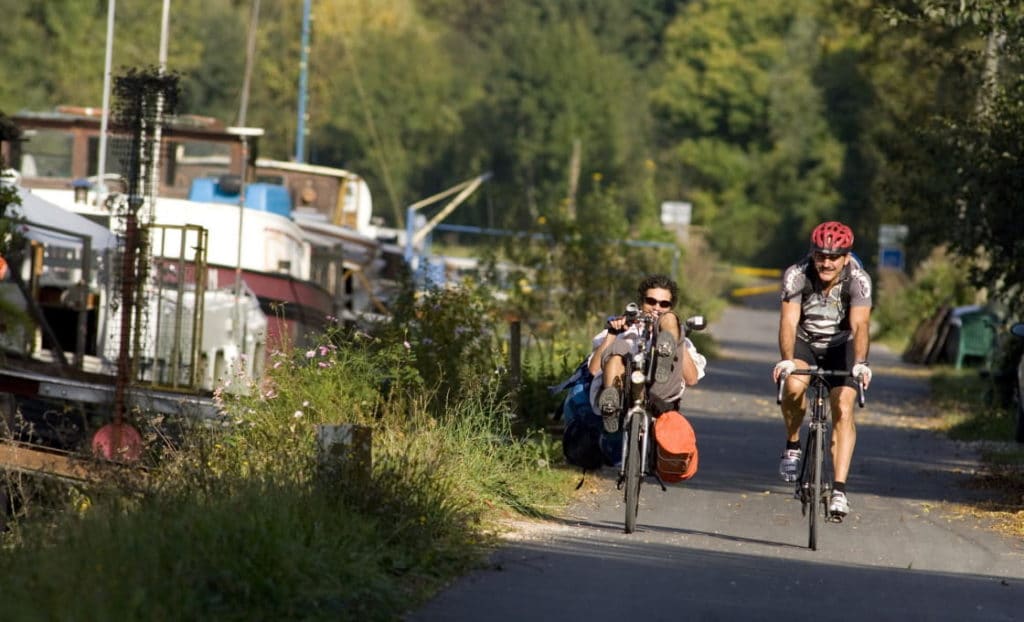Europe on the Eurovelo 6 is one of the world’s premier cycle paths, by any standard it is measured against: crossing 10 countries and visiting 11UNESCO sites / 4500km!
This is one of the most popular EuroVelo routes, and without any detours you will see coasts, rivers, castles, all the while enjoying top-class infrastructure and relatively flat topography. This is every cycle tourist’s dream journey. There are famous sections along the Loire and the Danube Rivers, but there are other gems hidden along the way. In France you’ll taste the best wines after cycling through the vineyards, in Vienna you’ll visit the most stunning museums, and in Serbia you’ll experience the warmth of the people. This article will explain why it is a great ‘asset’ for European tourism, and finish with a focus on some of the sections in France. Vive le velo for all!
The Eurovelo network was initially established from 1994 onwards by, among others, Jens Erik Larsen from Denmark. They created the Eurovelo 6 route, from the long-established Donauradweg, or Danube Cycle Path. The Loire à Velo was established (meaning significant collaboration from actors in the field) in 1995, and the works were finished in 2011. The Eurovelo network has beautiful maps and ambitious plans, but one must be wary of the dreaded dashed line… In reality some routes are not yet ‘certified’ or completed. Meaning that may cross into somewhat unsafe roads without signage.
Starting on the Atlantic coast, near Nantes, the EV6 traces the left and right banks of the Loire all the way to Digoin. Here it uses the excellent Burgundy by Bike network until Mulhouse on the sSwiss border. The short section in Switzerland is all of good quality, certified trail, as you would expect. There is a little climbing until the start of the Danube proper. Idyllic (somewhat downhill) cycling takes you through Bavaria and into Austria, Slovakia Hungary. The three capitals Vienne, Bratislava and Budapest are culturally important. After Belgrade the route enters into incredible gorges and allows an exploration of orthodox religion. The route has not been fully completed or signposted (as we write in June 2021) and has steeper sections. Downstream from Ruse there are two options, the Canal or continue following the last meanders of the river to its mouth. Constanţa is Romania’s largest and most important port city on the Black Sea, and the the gateway to the country’s seaside resorts, for some well needed relaxation. The whole route, taking it easy, and of course having days off will take you around 8 weeks. Whilst the distances may seem immense they are very manageable when spread over several weeks.
The route has been chosen with a thematic link (the rivers), and the logical idea that rivers flow along easy slopes; so cycling parallel is usually easier than crossing high mountain passes. Secondly, the route has been chosen for cultural interest, which is shown by the number of castles, along the way. Thirdly, all of these routes were chosen where land was available – it is easier for a local council to find land along a river and lay some infrastructure, rather than purchase numerous pieces of land through private property. The gradients are quite simple on this route, yet you will travel up to 900m above sea level near the source of the Danube.

The route takes you to places you may have never imagined visiting! The history and success of the Loire and Austrian Danube sections, yet this does not mean that the whole route is in good condition. There are certified sections of the route along the whole way, but many areas are on low trafficked roads open to the public motor vehicles, and some areas are along highly trafficked areas. These are usually temporary, but come as a warning to not presume that the whole of the route is in perfect condition. A 2018 report determined that 9.9% of the route was classified as highly attractive areas and 88.6% as attractive. Only 1.6% of the route were considered monotonous or unattractive.
Cycling this route is not like pioneering in the American West or travelling the steppes of Mongolia. The number of nearby accommodation spots, and restaurants, small grocery shops, and bike rental or repair agencies means you will not need any complicated logistics. The creation of this route has helped boost these local companies, and stimulated the villages along the trail. The density of services means that you do not need to do long stages, and many places have an abundance of accommodation meaning that you could also do a half stage.
First up, the journey along the Loire Valley is through an outstanding cultural landscape of great beauty, containing historic towns and villages, great architectural monuments (the châteaux!), and cultivated lands formed by many centuries of interaction between their population and the physical environment, primarily the river Loire itself. The area that is declared ‘important for world heritage’ starts before Angers until well after Orleans.
Further east, the eight UNESCO sites along the Danube river comprise: – the Frontiers of the Roman Empire (DE), – the Old town of Regensburg with the Stadtamhof (DE), – the Wachau Cultural Landscape (AT), – the Historic Centre of Vienna (AT), – the Srebarna Nature Reserve (SK), – Budapest, including the Banks of the Danube (HU), – the Rock-Hewn Churches of Ivanovo (BG) – and the Danube Delta (RO).
Perhaps avoid winter, or be prepared to struggle a bit more! Sadly, some suppliers along the route close in November, and the route is simply less pretty. Wine regions look nicer after the leaves come back on the vines. If you are taken by the idea of cycling in Europe (and have a few days to a few months free time ahead of you) ask us for a tailor-made quote in 2021.
Sources
- https://en.eurovelo.com/ev6
- http://www.interreg-danube.eu/uploads/media/approved_project_public/0001/28/c2a6b5bfb09f24eb306f8c147b2fc3b9a633ef59.pdf
- websites providing general information about the route include: www.danube.travel, www.crazyguyonabike.com








